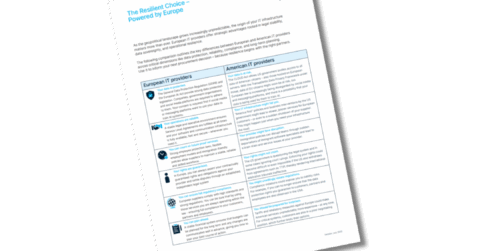Have you had your Emergency Response Practice Today?
by Eske Ofner, Head of Sales F24 AG

Why Training is such an Underestimated Component in Crisis Management and how to Prepare a Proper Training Plan.
“You never know what’s around the next corner.” There’s no clearer way to describe the work situation during crisis management. Within seconds, those responsible have to switch from normal business operations into crisis mode, with full concentration on the current situation.
Even while the crisis management team and emergency services are still in the process of developing an overall incident assessment, they have to make detailed localised decisions, but just when the human brain is required to make quick decisions, its reaction time slows down, as Cornelis Donders, a Dutch physiologist, discovered way back in the 19th century. Every single decision takes up precious time, making it critically important that the decision-makers don’t waste time thinking about central processes or how the technology works. Artists, competitive athletes and all those whose skills depend on precision and speed in demanding situations know that this skill can only be achieved through practice, practice and even more practice.
The Benefit of Regular Practice Sessions is Feeling of Being Well Prepared
Practice sessions are an essential component of proactive crisis management. No matter whether it is a large corporation or a small start-up, every company should regularly practice the response to potential crisis scenarios. After all, nothing contributes more to maintaining control in an emergency than being well prepared.
The good news is that nowadays people are becoming more aware of the importance of drills and training. According to the Emergency Communications Report from the Business Continuity Institute (BCI), the frequency of training in companies has increased. More than a third of companies (36%) conduct training at least twice a year or more, an increase of 12% from the previous year (24%). At the same time, the proportion of companies that reported that their emergency plans were not subject to regular practice checks fell from 4.2% in 2022 to 3.8%.

The advantages are obvious since it is only through proper training that companies can:
- Make sure that the plans are implemented as intended: Only by means of practice scenarios can it be seen whether every detail has been taken into account in the plans and whether all the procedures currently in place for an emergency will work as intended. Only those who can be sure that a particular measure will have the planned effect can act in a safe and confident way.
- Act faster and more systematically during a crisis: Through continuous training, those involved internalise the processes and can switch to “autopilot” mode much more quickly at the onset of an emergency. This leaves more time and energy free for the novel events that make every emergency a unique challenge.
- Continually update emergency and BCM plans: From outdated contact data, building layout changes or new business software, companies are in a constant process of change. Regular practice sessions not only ensure that all changes are taken into account in both the emergency and BCM plans, but also provide regular new insights for continuous improvement of the plans.

Keeping an Eye on the Details – The Main Focus of Attention during the Preparation Phase
Each crisis is different. No two practices are alike. As in real life crisis situations, the devil is often in the details of the crisis practice. From our own experience and on the basis of best practice examples from our clients, we recommend that you also keep the following in mind when preparing training sessions:
• Risks and Threats: Practice those scenarios that are classified as high-risk scenarios or whose likelihood of occurrence is highest.
• Emergency & Action Plans: Ensure that all plans are up-to-date and interconnected. It is best to map your emergency plans and the associated measures digitally in your crisis management software. In this way you have all the information in one place.
• Participants: Make sure that all the relevant people with the appropriate skills and competences participate in the training session.
• Räumlichkeiten: Ideally, the crisis team should have a room with all the necessary tools at its disposal. But if there is one thing we have learned from the pandemic crisis, it’s that nowadays crisis management must be able to take place in a totally digital environment. This makes it critical that your teams are able to communicate, delegate tasks and produce legally-compliant documentation digitally during a crisis.
• Technology: Test all necessary systems and technical equipment in advance of the practice session. It is best to use a crisis management solution that works independently of your own IT system. This saves time and headaches!
• Action Plans: Ensure that all action plans required for the practice session are up-to-date and logically interconnected.
• Time Frame: Check not only that the measures are working as planned, but also that they have been carried out within the desired time frame.
Properly and regularly conducted crisis management practice sessions require a certain amount of time and resources, but they are a worthwhile investment. The entire company and your stakeholders will thank you when the next emergency occurs.

„We always have our own personal contact at F24 who knows how to help us. Our feedback is directly reflected in the further development of the system. This is very valuable to us”.
Robin Casper, head of the H&R plant fire brigade at the Salzbergen site and Fire Safety Officer for the H&R companies at the site.
Training Correctly – 10 Steps to an Effective Training Programme
In order to develop the full potential of participants, training programmes need to be systematically structured and well planned. The BCI good practice recommendations provide effective guidelines for the development of a crisis training plan. This comprises the following 10 steps:
- Define a practice schedule, objectives and scope. It does not always have to be a large-scale crisis drill covering all departments. It is often sufficient to practice targeted minor situations in individual departments.
- Check any previous sessions for areas that were excluded from training in the past to ensure that each department is well prepared.
- Discuss with management where they see weaknesses and what priorities they want to set.
- Review and assess current risks and threats and design the practice sessions accordingly.
- Decide what types of practices should be carried out and what the main focus should be.
- Set a budget for the practice programme. A small budget is not necessarily synonymous with poor quality. For example, you can practise just one aspect of a scenario.
- Check the availability of the required staff, premises and other resources.
- Create a training plan that includes business continuity agreements with relevant parties.
- Have the plan approved by top management.
- Determine all the training requirements for the participants or planners and integrate them into the training programme.







